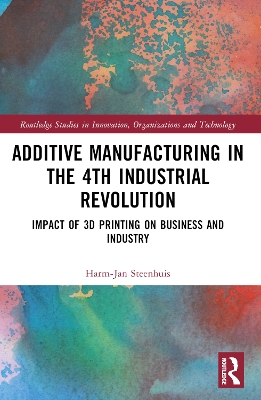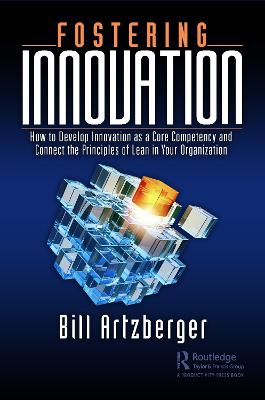Business of Additive Manufacturing
 portes grátis
portes grátis
Business of Additive Manufacturing
3D Printing and the 4th Industrial Revolution
Steenhuis, Harm-Jan
Taylor & Francis Ltd
12/2024
178
Mole
9781032505732
Pré-lançamento - envio 15 a 20 dias após a sua edição
Descrição não disponível.
CHAPTER 1: Manufacturing in the 21st century
Shift to services
Rise of developing countries
Reality of manufacturing
Industry 4.0
Additive manufacturing
Structure of the book
CHAPTER 2: Additive Manufacturing or 3D Printing: seven types
Comparing 'traditional' and AM
Material extrusion (MEX)
VAT Photopolymerization (VPP)
Powder bed fusion (PBF)
Material jetting (MJT) and binder jetting (BJT)
Directed energy deposition (DED) and sheet lamination (SHL)
Combination
Concluding remarks on AM technology
CHAPTER 3: The AM Business Case I: Comparing AM and TM Characteristics
Process choice
Technical capabilities - molds
Capabilities and performance objectives
Cost
Quality
Time
Flexibility
Innovation
Sustainability
The case for desktop 3D printers
CHAPTER 4: The spread of AM Technology
Technology and the economy
Adoption and diffusion
Adoption of the high technology: AM
CHAPTER 5: The AM Business Case II: Across the Value Chain
Delivering value
The client order decoupling point and service
Illustrative example
CHAPTER 6: Apparel
What is being 3D printed in apparel
Performance: why AM printing is used for apparel
How apparel is 3D printed: use of AM technology
Where apparel is 3D printed: AM in the apparel value chain
Diffusion and challenges of AM in apparel
CHAPTER 7: Construction
What is being 3D printed in construction
Performance: why AM printing is used for construction
How: AM technologies used in construction
Where AM is used in the construction value chain
Diffusion and challenges of AM in construction
CHAPTER 8: Food
What is being 3D printed in the food industry
Performance: why AM printing is used for food
How food is 3D printed: use of AM technology
Where AM is used in the food value chain
Diffusion and challenges of AM in the food industry
CHAPTER 9: Medical
What is being 3D printed in the medical field
Performance: why AM is used in the medical field
AM methods that are used for medical applications
Where in the medical value chain
Diffusion and challenges of medical AM
CHAPTER 10: Transport
What is being 3D printed related to transport
Performance: why AM printing is used in transportation
AM methods that are used for transportation applications
Where in the transportation value chain
Diffusion and challenges of AM in transportation
CHAPTER 11: Technological developments
Hardware
Software and digital files
Materials
Product quality
Delivery time
CHAPTER 12: Sustainability developments
Renewable resources
Minimization of resource usage
Source reduction
Recycling, reuse and repair
Regeneration, recovery, remanufacturing
Purification, end-of-pipe and degradation
Relationships between natural eco systems
AM and sustainability
CHAPTER 13: Legal developments
Legal issues with products
Legality of processes
Safety
Scams involving AM
CHAPTER 14: Conclusion
REFERENCES
INDEX
Shift to services
Rise of developing countries
Reality of manufacturing
Industry 4.0
Additive manufacturing
Structure of the book
CHAPTER 2: Additive Manufacturing or 3D Printing: seven types
Comparing 'traditional' and AM
Material extrusion (MEX)
VAT Photopolymerization (VPP)
Powder bed fusion (PBF)
Material jetting (MJT) and binder jetting (BJT)
Directed energy deposition (DED) and sheet lamination (SHL)
Combination
Concluding remarks on AM technology
CHAPTER 3: The AM Business Case I: Comparing AM and TM Characteristics
Process choice
Technical capabilities - molds
Capabilities and performance objectives
Cost
Quality
Time
Flexibility
Innovation
Sustainability
The case for desktop 3D printers
CHAPTER 4: The spread of AM Technology
Technology and the economy
Adoption and diffusion
Adoption of the high technology: AM
CHAPTER 5: The AM Business Case II: Across the Value Chain
Delivering value
The client order decoupling point and service
Illustrative example
CHAPTER 6: Apparel
What is being 3D printed in apparel
Performance: why AM printing is used for apparel
How apparel is 3D printed: use of AM technology
Where apparel is 3D printed: AM in the apparel value chain
Diffusion and challenges of AM in apparel
CHAPTER 7: Construction
What is being 3D printed in construction
Performance: why AM printing is used for construction
How: AM technologies used in construction
Where AM is used in the construction value chain
Diffusion and challenges of AM in construction
CHAPTER 8: Food
What is being 3D printed in the food industry
Performance: why AM printing is used for food
How food is 3D printed: use of AM technology
Where AM is used in the food value chain
Diffusion and challenges of AM in the food industry
CHAPTER 9: Medical
What is being 3D printed in the medical field
Performance: why AM is used in the medical field
AM methods that are used for medical applications
Where in the medical value chain
Diffusion and challenges of medical AM
CHAPTER 10: Transport
What is being 3D printed related to transport
Performance: why AM printing is used in transportation
AM methods that are used for transportation applications
Where in the transportation value chain
Diffusion and challenges of AM in transportation
CHAPTER 11: Technological developments
Hardware
Software and digital files
Materials
Product quality
Delivery time
CHAPTER 12: Sustainability developments
Renewable resources
Minimization of resource usage
Source reduction
Recycling, reuse and repair
Regeneration, recovery, remanufacturing
Purification, end-of-pipe and degradation
Relationships between natural eco systems
AM and sustainability
CHAPTER 13: Legal developments
Legal issues with products
Legality of processes
Safety
Scams involving AM
CHAPTER 14: Conclusion
REFERENCES
INDEX
Este título pertence ao(s) assunto(s) indicados(s). Para ver outros títulos clique no assunto desejado.
Industry 4.0;3D printing;manufacturing;AM;Leaning manufacturing;VPP;Powder Bed Fusion;Additive Manufacturing;PBF;3DP Processes;Bioprinting;Federal Aviation Administration;Hollow Cube;CPSs;Fourth Industrial Revolution;TM Process;CODP;Early Majority;Business Case;STL;Technology Organization Environment Framework;Selective Laser Sintering;Digital File;Vat;Food And Drug Administration;Clip;Hold;Vincent Van Gogh;Hearing Aid Shell;Build Platform
CHAPTER 1: Manufacturing in the 21st century
Shift to services
Rise of developing countries
Reality of manufacturing
Industry 4.0
Additive manufacturing
Structure of the book
CHAPTER 2: Additive Manufacturing or 3D Printing: seven types
Comparing 'traditional' and AM
Material extrusion (MEX)
VAT Photopolymerization (VPP)
Powder bed fusion (PBF)
Material jetting (MJT) and binder jetting (BJT)
Directed energy deposition (DED) and sheet lamination (SHL)
Combination
Concluding remarks on AM technology
CHAPTER 3: The AM Business Case I: Comparing AM and TM Characteristics
Process choice
Technical capabilities - molds
Capabilities and performance objectives
Cost
Quality
Time
Flexibility
Innovation
Sustainability
The case for desktop 3D printers
CHAPTER 4: The spread of AM Technology
Technology and the economy
Adoption and diffusion
Adoption of the high technology: AM
CHAPTER 5: The AM Business Case II: Across the Value Chain
Delivering value
The client order decoupling point and service
Illustrative example
CHAPTER 6: Apparel
What is being 3D printed in apparel
Performance: why AM printing is used for apparel
How apparel is 3D printed: use of AM technology
Where apparel is 3D printed: AM in the apparel value chain
Diffusion and challenges of AM in apparel
CHAPTER 7: Construction
What is being 3D printed in construction
Performance: why AM printing is used for construction
How: AM technologies used in construction
Where AM is used in the construction value chain
Diffusion and challenges of AM in construction
CHAPTER 8: Food
What is being 3D printed in the food industry
Performance: why AM printing is used for food
How food is 3D printed: use of AM technology
Where AM is used in the food value chain
Diffusion and challenges of AM in the food industry
CHAPTER 9: Medical
What is being 3D printed in the medical field
Performance: why AM is used in the medical field
AM methods that are used for medical applications
Where in the medical value chain
Diffusion and challenges of medical AM
CHAPTER 10: Transport
What is being 3D printed related to transport
Performance: why AM printing is used in transportation
AM methods that are used for transportation applications
Where in the transportation value chain
Diffusion and challenges of AM in transportation
CHAPTER 11: Technological developments
Hardware
Software and digital files
Materials
Product quality
Delivery time
CHAPTER 12: Sustainability developments
Renewable resources
Minimization of resource usage
Source reduction
Recycling, reuse and repair
Regeneration, recovery, remanufacturing
Purification, end-of-pipe and degradation
Relationships between natural eco systems
AM and sustainability
CHAPTER 13: Legal developments
Legal issues with products
Legality of processes
Safety
Scams involving AM
CHAPTER 14: Conclusion
REFERENCES
INDEX
Shift to services
Rise of developing countries
Reality of manufacturing
Industry 4.0
Additive manufacturing
Structure of the book
CHAPTER 2: Additive Manufacturing or 3D Printing: seven types
Comparing 'traditional' and AM
Material extrusion (MEX)
VAT Photopolymerization (VPP)
Powder bed fusion (PBF)
Material jetting (MJT) and binder jetting (BJT)
Directed energy deposition (DED) and sheet lamination (SHL)
Combination
Concluding remarks on AM technology
CHAPTER 3: The AM Business Case I: Comparing AM and TM Characteristics
Process choice
Technical capabilities - molds
Capabilities and performance objectives
Cost
Quality
Time
Flexibility
Innovation
Sustainability
The case for desktop 3D printers
CHAPTER 4: The spread of AM Technology
Technology and the economy
Adoption and diffusion
Adoption of the high technology: AM
CHAPTER 5: The AM Business Case II: Across the Value Chain
Delivering value
The client order decoupling point and service
Illustrative example
CHAPTER 6: Apparel
What is being 3D printed in apparel
Performance: why AM printing is used for apparel
How apparel is 3D printed: use of AM technology
Where apparel is 3D printed: AM in the apparel value chain
Diffusion and challenges of AM in apparel
CHAPTER 7: Construction
What is being 3D printed in construction
Performance: why AM printing is used for construction
How: AM technologies used in construction
Where AM is used in the construction value chain
Diffusion and challenges of AM in construction
CHAPTER 8: Food
What is being 3D printed in the food industry
Performance: why AM printing is used for food
How food is 3D printed: use of AM technology
Where AM is used in the food value chain
Diffusion and challenges of AM in the food industry
CHAPTER 9: Medical
What is being 3D printed in the medical field
Performance: why AM is used in the medical field
AM methods that are used for medical applications
Where in the medical value chain
Diffusion and challenges of medical AM
CHAPTER 10: Transport
What is being 3D printed related to transport
Performance: why AM printing is used in transportation
AM methods that are used for transportation applications
Where in the transportation value chain
Diffusion and challenges of AM in transportation
CHAPTER 11: Technological developments
Hardware
Software and digital files
Materials
Product quality
Delivery time
CHAPTER 12: Sustainability developments
Renewable resources
Minimization of resource usage
Source reduction
Recycling, reuse and repair
Regeneration, recovery, remanufacturing
Purification, end-of-pipe and degradation
Relationships between natural eco systems
AM and sustainability
CHAPTER 13: Legal developments
Legal issues with products
Legality of processes
Safety
Scams involving AM
CHAPTER 14: Conclusion
REFERENCES
INDEX
Este título pertence ao(s) assunto(s) indicados(s). Para ver outros títulos clique no assunto desejado.
Industry 4.0;3D printing;manufacturing;AM;Leaning manufacturing;VPP;Powder Bed Fusion;Additive Manufacturing;PBF;3DP Processes;Bioprinting;Federal Aviation Administration;Hollow Cube;CPSs;Fourth Industrial Revolution;TM Process;CODP;Early Majority;Business Case;STL;Technology Organization Environment Framework;Selective Laser Sintering;Digital File;Vat;Food And Drug Administration;Clip;Hold;Vincent Van Gogh;Hearing Aid Shell;Build Platform







